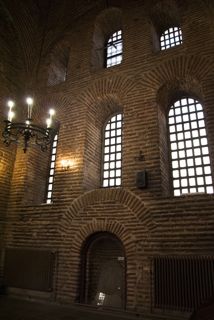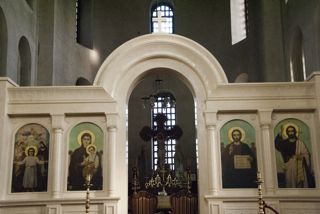Polina Spartyanova
When Constantine I the Great settled in his residence in Serdica for some time, he stated, "Serdica is my Rome." During the reign of the first Christian ruler of the Roman Empire, the future Bulgarian capital, Serdica, boasted significant economic and cultural progress. One of the symbols of that time, "St. Sofia" basilica, has been preserved to this day. Today "St. Sofia" church is located over it, which is the successor to the five smaller churches erected at different times within the Roman Empire. The first church was built soon after the issuance of the Edict of Milan by Emperor Constantine I the Great in 313 and the fifth was built during the reign of Justinian the Great (527-565). The constant attacks by Slavs, Avars and Bulgars caused great damage to the latter church. It is not yet certain when the church was rebuilt but Tsar Boris I the Baptizer had probably restored it to its current appearance after the conversion to Christianity.
 "St. Sofia" church is the most important symbol of today's capital of Bulgaria since in the mid 14th century the glory of the church was so great among the Slavic nations that the city of Sredets was renamed Sofia. The invasion of the Ottoman troops ended the glorious years of the church as in the 16th century they transformed it into a mosque and destroyed its frescoes. The strong earthquakes in 1818 and 1858 demolished the minaret and damaged the building, which the Muslims perceived as a bad omen and abandoned the building.
"St. Sofia" church is the most important symbol of today's capital of Bulgaria since in the mid 14th century the glory of the church was so great among the Slavic nations that the city of Sredets was renamed Sofia. The invasion of the Ottoman troops ended the glorious years of the church as in the 16th century they transformed it into a mosque and destroyed its frescoes. The strong earthquakes in 1818 and 1858 demolished the minaret and damaged the building, which the Muslims perceived as a bad omen and abandoned the building.
After the liberation of Bulgaria from Ottoman rule in 1878, the building of the church became an oil warehouse of the municipality of the capital and, from 1892 to 1898, there was a fire watchtower on the dome. In connection with the design of St. Alexander Nevsky Cathedral, a proposal had been made in the National Assembly to destroy "St. Sofia" and use the material in the construction of the monument of liberation but it was rejected.
 Today, visitors to the oldest active church in Sofia have the opportunity to experience the spirit of ancient Serdica by going a few metres down into the catacombs of the ancient basilica "St. Sofia". In the secret crypts of the church that occupy an area of 900 square metres, visitors can see more than 50 Roman tombs and the remains of churches that had been built before "St. Sofia".
Today, visitors to the oldest active church in Sofia have the opportunity to experience the spirit of ancient Serdica by going a few metres down into the catacombs of the ancient basilica "St. Sofia". In the secret crypts of the church that occupy an area of 900 square metres, visitors can see more than 50 Roman tombs and the remains of churches that had been built before "St. Sofia".
The church is of critical importance for Bulgarian society because the official memorial of the Republic of Bulgaria, namely the Monument of the Unknown Soldier with the eternal flame, is erected to the south of it and famous Renaissance writer Ivan Vazov is buried to the east.
